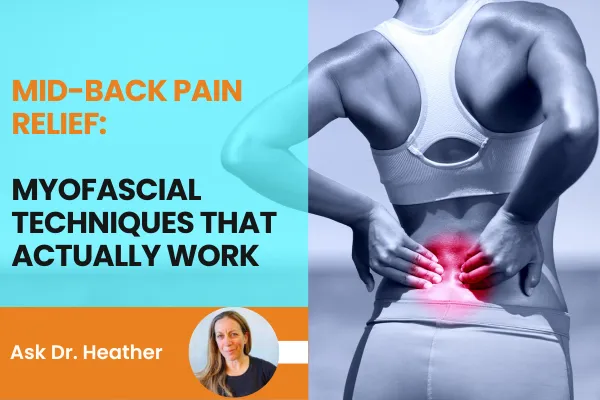Ask Doctor Heather Advice Corner

Mid-Back Pain Relief: Myofascial Techniques That Actually Work
Remote work got you hunching at your desk?
Many of us are experiencing mid-back pain and stiffness due to prolonged hours spent hunched over our makeshift home workstations. The good news is that there are simple exercises and stretches you can do at home to alleviate this discomfort and improve your thoracic mobility.
Understanding Mid-Back Tension & Thoracic Spine:
The area we're targeting is right between the shoulder blades, a common trouble spot due to prolonged sitting or poor posture. Women, especially, may experience tension in this area due to increased breast size or other factors.
In this blog post, we'll guide you through these exercises and help you regain flexibility and comfort in your mid-back.
Before we dive into the exercises, it's essential to understand the thoracic spine's location. The thoracic spine is the part of your spine that extends from the base of your neck to the top of your shoulders. It consists of 12 vertebrae and is the region where you often feel tightness and discomfort, especially when your shoulders are rolled forward due to poor ergonomics.

Exercise 1: Foam Roller Pec Stretch
Lay on your back with a foam roller lengthwise beneath you.
Keep your palms open and let your shoulders depress, allowing your chest to open.
Hold this position for about five seconds.
Cross your arms over your chest and gently rock side to side to target the mid-back.
Exercise 2: Foam Roller Mid-Back Release
Lay on the foam roller with the roller positioned horizontally, supporting your mid-back.
Cross your arms over your chest.
Gently rock up towards the top part of your shoulder blades and back down.
You can lean to one side to focus on specific areas.
Exercise 3: Thoracic Spine Mobility with a Therapy Ball
Stretch your arms out on a therapy ball, lowering your head towards the floor.
Push your hips out behind you, holding this position for a few seconds.
Thread the needle by rolling the ball to the side and bringing one arm through.
Repeat on the other side to enhance the stretch.
Exercise 4: Thoracic Mobility with TRX
For the "Golf Swing" exercise, hold onto TRX handles with your knees slightly bent.
Open up your body to one side, looking at your hand, and return to the center.
You'll feel this stretch behind your shoulder blades and in your lumbar spine.
To increase the stretch, look at your hand as you open up.
Exercise 5: Thoracic Extension with TRX
Hold the TRX handles with your arms extended overhead.
Lean back, allowing your feet to lift, and stretch your body.
Rotate to one side, looking at your armpit, and return to center.
Repeat on the other side for an excellent thoracic spine stretch.
Exercise 6: Thoracic Rotation on the Floor
Lay on your back and let both legs fall to one side, opening up your body.
To target the lower thoracic area, allow your legs to fall further.
For higher thoracic mobility, lay on your side and open up your body by rotating.

Benefits of These Exercises: Now that you know the exercises let's delve into why they are effective for reducing mid-back pain and improving thoracic mobility:
Improved Posture: Prolonged sitting and poor workstation setups can lead to rounded shoulders and a hunched posture. These exercises help open up your chest and pull your shoulders back, promoting better posture.
Release Tension: The foam roller and therapy ball exercises target tight muscles in the chest, mid-back, and between the shoulder blades, releasing tension and promoting relaxation.
Increased Range of Motion: The TRX exercises and thoracic rotation stretches promote greater range of motion in your thoracic spine, allowing you to move more freely and comfortably.
Pain Reduction: By addressing the root causes of mid-back pain, these exercises can provide relief from discomfort, especially if you've been experiencing headaches due to tension in your neck and shoulders.
Strengthened Muscles: While these exercises focus on flexibility and mobility, they also engage and strengthen various muscles in your upper body, leading to better overall stability.
Incorporating These Exercises into Your Routine: To reap the benefits of these exercises fully, it's essential to incorporate them into your daily routine.
Here's a suggested plan:
Morning Routine (5-10 minutes):
Start with the foam roller pec stretch to open up your chest.
Follow up with the foam roller mid-back release.
Perform a few minutes of thoracic rotation on the floor to wake up your spine.
Midday Break (2-3 minutes):
Take a break from work, and if possible, do the TRX exercises or thoracic extension to counteract any mid-back tension that may have built up.
Evening Routine (5-10 minutes):
Use the therapy ball to work on thoracic spine mobility.
Conclude with the foam roller mid-back release to relax your muscles before bedtime.
FOAM ROLLING YOUR WAY TO BACK-PAIN RELIEF
Another way you can reduce your back pain and relieve tension is with a foam roller. We break down the exact steps below:
Using the Foam Roller: If you have a foam roller, we'll start by using it to break down tissue in your mid-back.
Lay the foam roller lengthwise beneath you.
Begin by stretching out your chest with your arms dangling to the sides.
Hold this position for five seconds.
Cross your arms over your chest and gently rock side to side, allowing the scapulae to move.
Repeat the process with arms crossed the other way for balance.
Mid-Back Release: Next, we'll focus on the mid-back area between the shoulder blades. This exercise can provide significant relief.
Lay on the foam roller with it positioned horizontally, supporting your mid-back.
Cross your arms over your chest.
Gently rock up towards the top part of your shoulder blades and back down.
You can lean to one side to focus on specific areas.
Scapular Area and Lats: To target the scapular area and the lats (latissimus dorsi), which can contribute to mid-back tension, try this technique:
Place the roller right where your bra line would be.
Cross your arms over your chest.
Lift your hips off the ground and move up and down, focusing on the spine of the scapula.
You can also lean to one side to work on the subscapular area.
Lats Release: If you're dealing with sensitivity or tightness in the lats, this exercise can help:
Lay on your side with your top leg over and your arm extended.
Lean back slightly.
You may feel some discomfort and trigger points in this area.
To address it, lift your body and roll gently.
This might be the most sensitive area, but it's crucial for relieving mid-back pain.
These simple exercises and stretches are your ticket to reducing mid-back pain and enhancing thoracic mobility, even if you're working from home with limited equipment. By incorporating them into your daily routine, you'll not only find relief from discomfort but also experience improved posture and flexibility.
Remember to listen to your body and consult with a healthcare professional if you have any underlying medical conditions or concerns. Here's to a healthier, pain-free mid-back!






